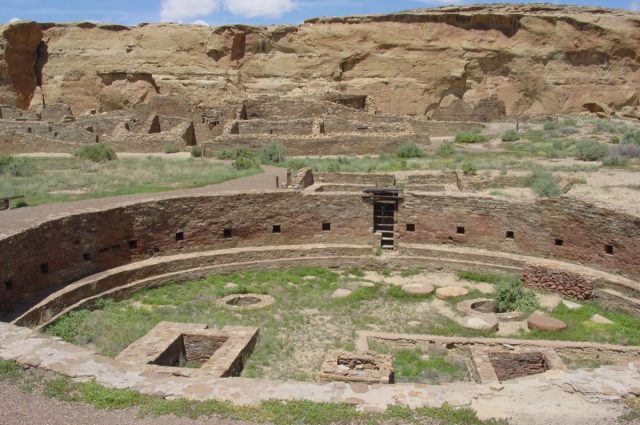
Patrick Campbell/CU Boulder
The so-called « great houses » of Chaco Canyon in New Mexico may have taken decades or longer to construct. Most large complexes had four or five stories and averaged over 200 rooms, with the largest boasting as many as 700 rooms. The complexes also featured large circular ceremonial areas called kivas. In order to construct these great houses, archaeologists have estimated that the Chacoans would have needed wood from some 200,000 trees, and those 16-foot-long wooden beams must have been transported from mountain ranges as far as 70 miles (110 km) away.
Many scientists have hypothesized about how the Chacoans might have accomplished this feat. The latest theory is that the Chacoans may have used simple devices called tumplines, still favored by sherpas in Nepal, according to a new paper published in the Journal of Archaeological Science: Reports. To test that hypothesis, co-authors Rodger Kram and James Wilson spent the summer of 2020 training until they could haul a heavy log some 15 miles using tumplines. « Some people baked sourdough bread during COVID, » said Kram, an emeritus professor of integrative physiology at the University of Colorado at Boulder. « Instead, we carried sand and heavy logs around using our heads. »
There are no preserved timber scrape marks near the site, and the people of Chaco Canyon didn’t have draft animals or even wheels, according to Kram and his co-authors. So the logs must have been carried by people, most likely along the wide roadways that linked this world. A 1925 publication featured a photograph depicting eight young men from Zuni Pueblo carrying a log: four on each side holding thin cross-poles at hip-height, with the log laid on top. That photograph influenced many of the proposed mechanisms for transporting the logs. However, Kram et al. pointed out that there’s no clear evidence that the residents of Zuni Pueblo share cultural connections with the people who once inhabited Chaco Canyon. « We feel that it is dubious to infer Chaco era timber transportation methods from a staged 20th century image, » they wrote.
Others have suggested that the timbers were rolled rather than carried to construction sites, perhaps bundled within smaller wood pieces for protection or carried on the shoulders. And the published oral traditions and ethnography of the Pueblo and Dineo peoples descended from the Chachoans don’t shed much light on the issue, either. There is one account of the timbers for Pueblo Bonita being hauled on little wagons made of a small tree, with a cross-section at either end serving as a rudimentary wheel. But that account is inconsistent with the known sourcing of the timbers—the Chuska, Zuni, San Mateo, La Plata, ad Sa Juan Mountains—and there is also no archaeological evidence for the existence of such carts, according to the authors.

Pubic domain
Kram developed his own theory about how the Chacoans managed the feat, starting with his realization a few years ago that the assumptions since 1980 about the mass of a typical roof beam (viga) used in one of the great houses was likely too high: 275 kilograms, a bit more than 600 pounds. “I cut a 1-foot-long section of pine and weighed it on my bathroom scale,” said Kram. “I multiplied by 16 feet and realized, ‘That can’t add up to 275 kilograms.’”
He and Wilson, who was then an undergraduate in biochemistry at CU-Boulder, read up on the properties of dried wood and published their conclusions last year. They estimated that a 16-foot-long pine log weighed closer to 85 kilograms, or just over 185 pounds. That changed the calculation significantly when determining how many people would have been needed to carry the timbers 60-70 miles. And they decided to test whether the journey was possible themselves.










